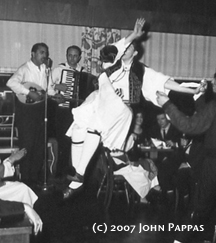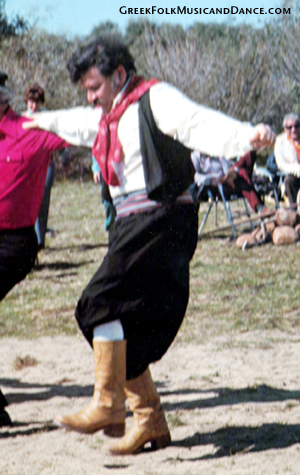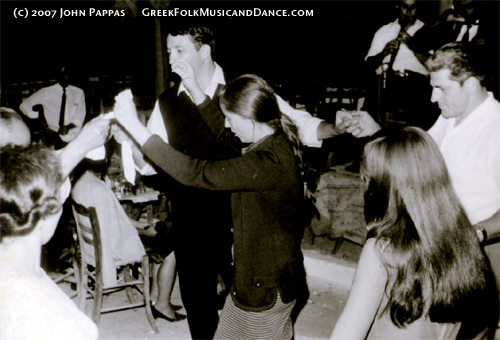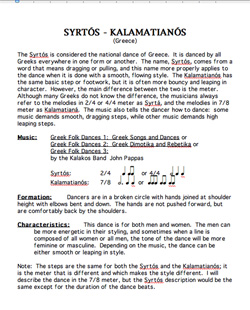Greek Folk Dance Book/Dance Descriptions For Sale

John dancing the Tsamiko to the music of John Kaplanis
at the El Cid in San Francisco, 1960.
The second edition of my book, Ethnic Dances of Greece, is available.
The book includes descriptions for forty (40) Greek folk dances. These are written descriptions of the steps. Note that a person cannot learn these dances from the descriptions alone; they really must see the style of the movements of a dance to fully understand it.
The book is bound, and includes the dances from our CDs plus many more. The cost is $25. If you buy a set of four CDs, we will also give a $2 discount on the book ($23). These prices do not include shipping.
Single dance descriptions cost $1.00 each, not including shipping.
Below, I've included a list of dances included in the book (and available as single dance descriptions), as well as a sample dance description. An introduction to Greek folk dance in general is available on my Greek folk dance page.
Ordering and Payment
To order individual descriptions and/or the second edition of the book (shipping costs will vary), or for more information, email John.
Once he confirms availability and provides you with a final total (including shipping), you can pay online with Paypal. With prior arrangement, you can also send a check or USPS money order to us, but Paypal is the quickest method (we ship as soon as payment clears, and Paypal payments clear pretty much immediately).
Dances in Alphabetical Order:

Stefanis Facaros dancing Hasaposervikos.
- Andikrystos
- Ballos
- Beratis
- Diplos Horos Arkadias
- Fysouni
- Gaida
- Hasapikos (Hasaposervikos)
- Hasapikos Argos
- Hiotikos
- Ikariotikos
- Karagouna
- Kastrinos
- Kleftes
- Kotsarin
- Lahana
- Lefkaditikos
- Len Irthi Mais
- Levendikos
- Menousis
- Miteritsa
- Nisiotikos Syrtos
- Pentozalis
- Pos to Trivoun to Piperi
- Siganos
- Sousta Rodou
- Sta Dyo
- Sta Tria
- Syrtos Botaitikos
- Syrtos Haniotikos
- Syrtos Koftos
- Syrtos Pylaias
- Syrtos Thrakis
- Syrtos-Kalamatianos
- Tapeinos
- Tik
- Trata
- Tsakonikos
- Tsamikos
- Zagorisios
- Zonaradikos
Dances by Region:

Dance book cover.
Arkadia
Diplos Horos Arkadias; Syrtos Botaitikos; Syrtos Koftos; Tsakonikos
Epiros
Beratis; Fysouni; Kleftes; Menousis; Sta Dyo; Sta Tria; Zagorisios
Makedonia
Andikrystos; Gaida; Levendikos; Syrtos Pylaias
Pontos (Black Sea - Asia Minor)
Kotsarin; Lahana; Miterítsa; Tik
Roumeli and Peloponnisos
Pos to Trivoun to Piperi; Trata
Thraki
Len Irthi Mais; Syrtos Thrakis (Syngathistos Thrakis); Tapeinos; Zonaradikos
Thessaly
Karagouna
Islands - Aegean
Ballos; Hiotikos; Ikariotikos (Ikaria); Nisiotikos Syrtos; Sousta Rodou (Rhodes)
Islands - Ionian
Lefkaditikos
Islands - Crete
Kastrinos; Siganos; Pentozalis; Syrtos Haniotikos
Pan-Hellenic or Tavernes (Rebetika)
Hasapikos (Hasaposervikos); Hasapikos Argos; Syrtos-Kalamatianos; Tsamikos
Dance Description Sample

Dancing Kalamatianos in Kandyla. August 15, 1970. John and Paula Pappas.
Note: It is really not possible to learn a dance correctly from a dance description alone. Such descriptions are good as reminder notes, or as a way to analyze the structure of the step pattern. The only way to correctly learn these dances is by dancing with the Greeks, especially at celebrations. A good teacher who is from the culture and really understands the spirit and ethos of the dance culture can also be a valuable resource. Please accept the following description as only a note on the most popular of all of the Hellenic dances. Also, be aware that the commercial versions of the dance descriptions include musical notations and other features not available on this page.
Dance Description: SYRTOS - KALAMATIANOS

Sample dance description: Page one.
The Syrtos is considered the national dance of Greece. It is danced by all Greeks everywhere in one form or another. The name, Syrtos, comes from a word that means dragging or pulling, and this name more properly applies to the dance when it is done with a smooth, flowing style. The Kalamatianos has the same basic step or footwork, but it is often more bouncy and leaping in character. Actually, the main difference between the two is the meter. Although many Greeks do not know the difference, the musicians always refer to the melodies in 2/4 or 4/4 meter as Syrta, and the melodies in 7/8 meter as Kalamatiana. The music also tells the dancer how to dance: some music demands smooth, dragging steps, while other music demands high leaping steps.
Formation: Dancers are in a broken circle with hands joined at shoulder height with elbows bent and down. The hands are not pushed forward, but are comfortably back by the shoulders.
Characteristics: This dance is for both men and women. The men can be more energetic in their styling, and sometimes when a line is composed of all women or all men, the tone of the dance will be more feminine or masculine. Depending on the music, the dance can be either smooth or leaping in style.
Note: The steps are the same for both the Syrtos and the Kalamatianos; it is the meter that is different and which makes the style different. I will describe the dance in the 7/8 meter, but the Syrtos description would be the same except for the duration of the dance beats.
Kalamatianos: 7/8 meter: 3/8, 2/8, 2/8 (counted as LONG, SHORT, SHORT or 1+, 2, 3)
Syrtos: 4/4 meter: 4/8, 2/8, 2/8 (counted as LONG, SHORT, SHORT or 1+, 2, 3)
Weight is on the left foot.
Measure I:
1+ Step sideward to right on Right ft.
2 Step behind the right on Left ft.
3 Step sideward to right on Right ft.
Measure II:
1+ Step across in front of the right on Left ft.
2 Step sideward to right on Right ft.
3 Step across in front of right on Left ft.
Measure III :
1+ Step slightly to side (right) on Right ft.
2 Step slightly forward (towards center) on Left ft.
3 Step in place on Right ft.
Measure IV:
1+ Step next to right on Left ft.
2 Step slightly forward (towards center) on Right ft.
3 Step in place on Left ft.
Note: There are many variations and improvisations that the leader or individual dancers can do. Many of these step variations are done by individuals as their creativity and improvisational mood tells them. Especially, there are variations in Measures 3 and 4.
The leader may do fancy step variations and turns. Male leaders may do squat steps or slap the feet. Individual dancers do not try to follow or imitate the leader. A very common variation is for the dancers to skip or hop immediately before the first step in each measure, especially before the step across on the left foot at the beginning of measure two. Instead of joining hands, the second dancer often holds a mandili (kerchief or scarf) to support the lead dancer.
This page was last updated on 10/8/2024.
